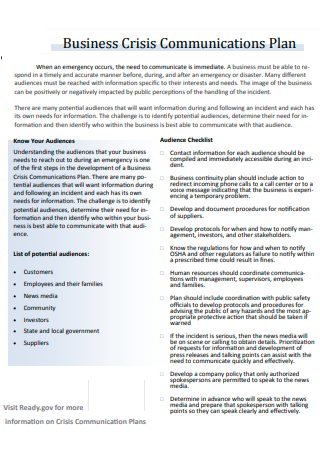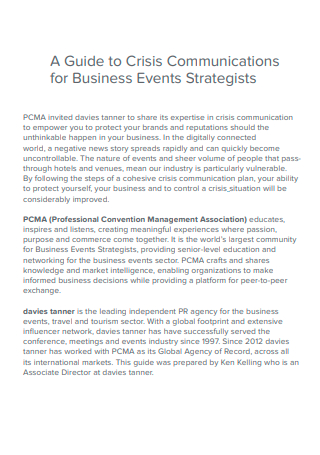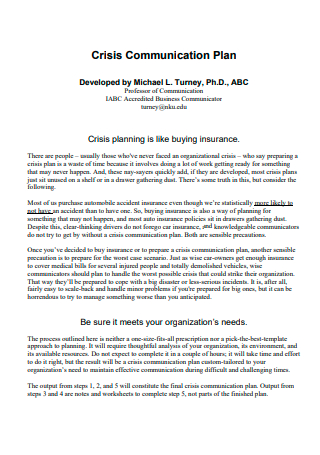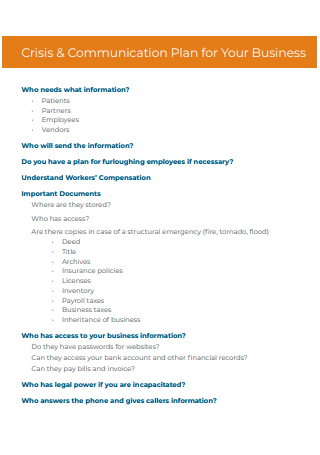4+ Sample Business Crisis Communication Plan
FREE Business Crisis Communication Plan s to Download
4+ Sample Business Crisis Communication Plan
What IS a Business Crisis Communication Plan?
What are the 4 Common Types of Business Crisis?
Making the Business Crisis Communication Plan
FAQs
What is the definition of a business crisis?
What are some of the common crisis management strategies?
How important is crisis communication?
What IS a Business Crisis Communication Plan?
A crisis can come with or without a warning. More so when it comes to a business’s operation. That is why having a business crisis communication plan is crucial in any business, all the more in a corporate setup. A business crisis communication plan is a business’s guide in handling and addressing the crisis, emergencies, or disasters that significantly impacts a business’s reputation. It is a communication process on how to reach out to the public and to the stakeholders to try to get the right information out, have visibility and transparency, to maintain that level of trust between all stakeholder groups. A business crisis communication plan is often handled by the public relations team, or else, by a separate team that’s formed specifically to deal with crises. Having a marketing plan can only get you as far as reaching out to potential targeted customers and accomplishing sales revenue goals, but when it comes to crisis handling, it’s a whole different story. The ultimate goal of a crisis communication plan is to anticipate and to prepare steps in the event of a crisis that involve creating communication strategies to reach out to the public, minimizing any damages or impacts caused by the situation, and eventually take steps to prevent the same occurrences from happening again in the future.
What are the 4 Common Types of Business Crisis?
No two crises are the same. Crisis communication planning, aside from being an integral part of a business operation, should also be flexible enough to meet all types of crises. Preparing is at the key core of a crisis communication plan. If you don’t prepare, if you don’t anticipate, the damages incurred to your business stemming from the crisis will be far greater than you would have imagined. Crises come in different shapes and sizes, coming from all sorts of woodwork, cracks, and crevices. Identifying the type of crisis is important so that your planning could easily act accordingly to fit in the right resolution with handling a particular crisis. Below are some of the common types of business crises encountered by today’s corporate world.
Making the Business Crisis Communication Plan
Preparation is key to success may sound a bit cliche, but nothing is closer to truth, especially when dealing with a crisis. That is what a business crisis communication plan seeks to do, and that is to be prepared in effectively communicating and imparting information that helps a business reputation in the event of a crisis. A lot of case scenarios over the years have shown that having a business, marketing, and financial plan is not enough to run a business. A contingency should be set in place in the form of crisis communication planning. There is no strict format when it comes to creating a business crisis communication plan, but to make a crisis communication plan effective, the following elements need to be included.
-
1. Executive Summary
The executive summary establishes the background of the business, the need for a crisis communication plan, and the goals and objectives of the plan. If the business is in the information technology industry, then the crisis communication plan should be made specifically for IT adverse events or crises. Same if the business is in clothing manufacturing, food industry, and so on. The executive summary gives an outline of what is written and included in the crisis communication plan as a way of introduction for the planning process. Executive summaries oftentimes also include a mission and vision statement. A mission statement states the reason or purpose behind a crisis communication plan, while a vision statement describes what the planning hopes to achieve with their strategies or action steps in dealing with the crisis.
-
2. Identifying the Crisis Management Team
The next step is to identify the team that will be responsible for crisis management and communication. External communications are largely handled by a public relations group which could be an internal part of the company or hired third-party agencies. In some cases, a crisis management team is also formed as a separate group within the organization, but working closely with the public relations and the management team. Their role mainly is to handle and deal with crises and their aftermaths, the frontliners for information when a crisis happens. And as part of the communications planning, to be in charge of information dissemination and communication with the company’s stakeholders. They handle the speeches, newsletters, communique made to the media, announcements, bulletin posts, and even online and social media posts.
-
3. Identifying and Assessing Crisis Scenarios
Now that you have your crisis management team, the next step is to identify what are the possible crises, emergencies, or disasters that your business could face, including the possible effects and damages. Communication planning should be made specific to a particular crisis scenario. If a business is in the information technology trade, what are the possible problems or threats that the business could encounter? For the IT business, a crisis could come in the form of cyber security issues such as cyber-attacks in the form of malware threats, phishing, password attacks, and so on, or any digital form of threats that could potentially cause business and financial loss or disruption to operations. In manufacturing or production trade, a crisis could be a sudden shortage of supply, poor manpower management that led to workers’ strikes and halts in operations, and so on. In the food industry such as the restaurant or food supplier, it could be a case of sudden food poisoning of a customer, shortage of food supply, or even a rogue employee, or even a very rude customer, that led to disruption of the food operations or service.
-
4. Identifying the Stakeholders
Identifying your partner stakeholders is crucial in coming up with a business crisis communication plan. Who are your stakeholders? Who are the persons involved in the operation of your business, directly or indirectly? Who are the persons greatly affected if something happens to your business? The stakeholders could be the company’s employees, investors, business partners, customers and clients, and even the public at large. Why the public? Because the public’s opinion is crucial in any incident that happens in your business. Their opinion could make or break your business. If the majority expressed that your company was not able to handle the crisis well and appropriately, it could mean the end of the line for your business. Or if the majority of the public showed their approval and admiration with the way that your company dealt with its issues, aside from a boost in the company’s and brand’s image, it could boost customer loyalty and patronage, which meant a boost in the sales revenue as well.
-
5. Communication Strategies
Next is to create communication strategies in anticipation of possible crises. The strategies should adhere to a SMART goal method, which means strategies that are specific, measurable, achievable, relevant, and time-bound. Social media and social networking platforms are the best channels to communicate with your stakeholder partners. The traditional methods of preparing press releases, newsletters, or press conferences are still effective means of strategic communication. In crisis communication, fast or speed is the key. Every second counts when delivering the message. If communication was put out just moments after an incident or an event took place, it boosts the level of confidence the public places on the business because it means that the company is staying on top of things and is aware of everything that’s going on from the ground. Having a good spokesperson is another effective strategy. The spokesperson should be carefully selected since they’re the ones representing the company and facing the public. Creating a fact sheet during a crisis is also another important strategy. Fact sheets contain the list of information or details about the crisis that should be disseminated to the team and to the media to prevent spreading rumors or misinterpretation and misrepresentation about the crisis. These fact sheets should be created almost immediately at the onset of the crisis event. Another strategy is to train the customer service team on what is the best way to handle customer concerns during a crisis through training on empathy, writing, or responding skills.
FAQs
What is the definition of a business crisis?
A business crisis is often an unexpected event taking place which greatly impacts and negatively affects a business’s production, operations, and financial revenue stream. It is also an event or an incident that could affect the employees’ morale and the business’s reputation.
What are some of the common crisis management strategies?
The three common types of crisis management strategies are responsive crisis management, recovery crisis management, and proactive crisis management. Responsive crisis management is an on-the-spot strategy created to address an ongoing crisis and to limit the crisis’s impact on the business’s operation. Recovery crisis management helps mitigate and stabilize the effect and impact of the unexpected onslaught of a crisis. While proactive crisis management is the anticipating and planning strategically in advance steps to be taken in a future crisis scenario by identifying what are the potential threats to the business’s operation.
How important is crisis communication?
Crisis communication is designed to protect a company, an individual, or an organization when it comes to its reputation during a crisis. It is aimed at providing information and awareness of the actual nature of the situation, the impact it has, and providing the steps necessary to reduce future risks or potential damages.
The world-famous beverage company PepsiCo’s handling of its 1993 crisis is one for the books and public relations history. Their story sets forth the reason why it is important to have a good and effective business crisis communication plan. More than just a piece of the planning document, a well-written and prepared crisis communication plan can do wonders for a business in event of any crisis, emergency, or potential threats.
Need help in creating one? Check out our business crisis communication plan templates. Our templates are ready-drafted so that it’s easy for you to fill out and to use at your convenience. Download one now!





